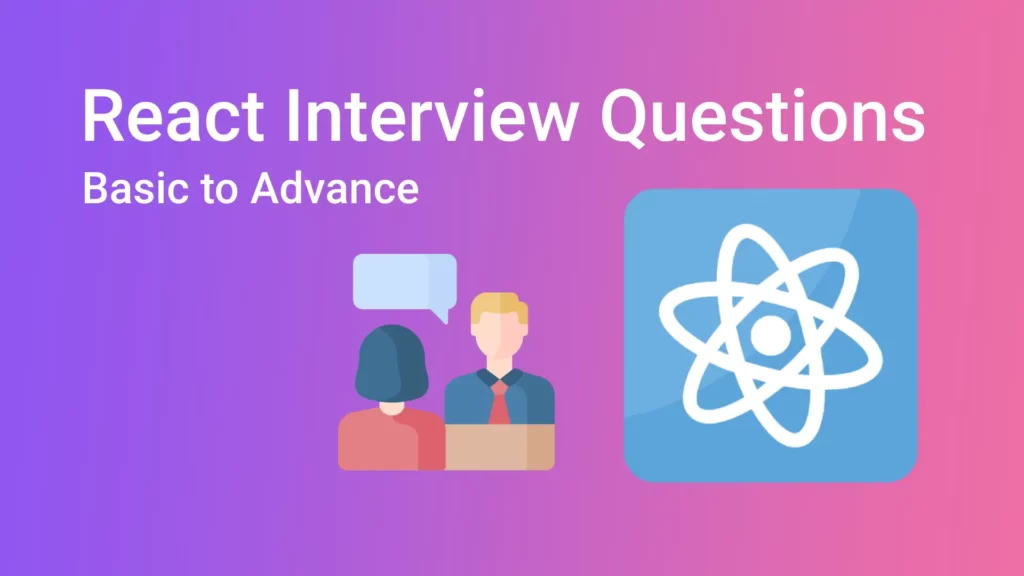The word “react” is currently very popular in the sector. React is currently the most widely used front-end technology, and as more businesses adopt it, this course on ReactJS interview questions is ideal for those who are prepared for job interviews. Here is a thorough collection of every typical ReactJS interview question, ranging from the most basic to the most complex. from beginner to advance level.
Most Commonly Asked React Interview Question And Ansers
1. What is React?
An open-source JavaScript front-end library called React is used to create user interfaces, particularly for single-page applications. It manages the view layer for both online and mobile applications. Jordan Walke, a software engineer for Facebook, developed React. In 2011 and 2012, respectively, Facebook’s News Feed and Instagram introduced React.
2. What are the major features of React?
React’s main characteristics include:
- Given that RealDOM manipulations are costly, VirtualDOM is used instead.
- Supports server-side rendering.
- Follows data binding or unidirectional data flow.
- Develops the view using reusable/composable UI components.
Get 200+ Hours Free Courses.
3. What is JSX?
- JavaScript XML is referred to as JSX.
- We can write HTML in React thanks to JSX.
- React’s use of JSX makes adding and writing HTML simpler.
class App extends React.Component {
render() {
return(
<div>
<h1>{'Welcome to React world!'}</h1>
</div>
)
}
}4. What is the difference between Element and Component?
React Element: It is an object representation of a fictional DOM node that serves as the fundamental building element of a react application. Type and property are both included in React Element. Other Elements might be present in its props. React Element is lighter and renders more quickly than components because it lacks any functions.
import React from 'react';
import React from 'react';
import ReactDOM from 'react-dom';
// Without JSX
const ele1 = React.createElement(
'h1',
{id:'header'},
'Hello World'
);
ReactDOM.render(ele1,document.getElementById('root'));
React Component: It is stand-alone and recyclable. It provides the element’s virtual DOM. When constructing a component, one has the option of passing any argument or not. Functional and class components are additional categories of a component.
import React from 'react';
import ReactDOM from 'react-dom';
function Welcome(user){
return <div>
<h3>Hello {user.name}</h3>
</div>
}
const ele = <Welcome name="World"/>
ReactDOM.render(ele,document.getElementById("root"));
Top HTML Interview Answers and Questions.
5. How to create components in React?
A component can be made in one of two ways.
Function Components: The simplest approach to build a component is with a function component. These are pure JavaScript functions that take a props object as their first input and output React elements:
function Greeting({ message }) {
return <h1>{`Hello, ${message}`}</h1>
}Class Components: Additionally, you can define a component using an ES6 class. You can write the given function component as:
class Greeting extends React.Component {
render() {
return <h1>{`Hello, ${this.props.message}`}</h1>
}
}6. When to use a Class Component over a Function Component?
Use a class component if the component requires state management or lifecycle management; otherwise, use a function component. With the introduction of Hooks in React 16.8, you may now access state, lifecycle methods, and other capabilities that were previously only available in class components in your function component.
Therefore, using Function components is always advised, unless you require a React functionality for which there isn’t yet a Function component equivalent, such as Error Boundaries.
7. What are Pure Components?
React.PureComponent is exactly the same as React.Component except that it handles the shouldComponentUpdate() method for you. When props or state changes, PureComponent will do a shallow comparison on both props and state. Component on the other hand won’t compare current props and state to next out of the box. Thus, the component will re-render by default whenever shouldComponentUpdate is called.
8. What is state in React?
A component’s state is an object that contains data that could change throughout the course of the component’s existence. Our state should always be kept as straightforward as possible, with the least amount of stateful components possible.
class User extends React.Component {
constructor(props) {
super(props)
this.state = {
message: 'Welcome to React world'
}
}
render() {
return (
<div>
<h1>{this.state.message}</h1>
</div>
)
}
}State is equivalent to props, but it is private and entirely under control of the component; as a result, it is not accessible to any other component until the owner component decides to pass it.
9. What are props in React?
Props serve as inputs for components. They are supplied to components during creation using a naming method related to HTML-tag attributes. They can be single values or objects holding a collection of data. They are information that a parent component transmits to a child component.
10. What is the difference between state and props?
State and props are both simple JavaScript objects. Despite the fact that they both contain data that affects render output, their component-specific functionality varies. While state is managed within the component similarly to variables specified within a function, props are supplied to it like function parameters.
More Questions Will Be Added SOON!
Note: All the questions and answers are collected from the internet.



